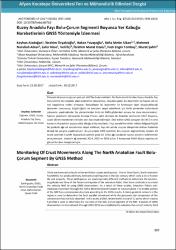| dc.date.accessioned | 2018-06-22T10:00:04Z | |
| dc.date.available | 2018-06-22T10:00:04Z | |
| dc.date.issued | 2017 | |
| dc.identifier.uri | Monitoring Of Crust Movements Along The North Anatolian Fault BoluÇorum Segment By GNSS Method | |
| dc.identifier.uri | http://hdl.handle.net/11630/4833 | |
| dc.description.abstract | Dünyada deprem oluşturan pek çok aktif fay bulunmaktadır. Bu faylardan birisi olan Kuzey Anadolu Fay
Zonu (KAFZ) son yüzyılda yıkıcı depremler oluşturmuş, meydana gelen bu depremler ise büyük can ve
mal kayıplarına neden olmuştur. Gerçekleşen bu depremler ile kırılmayan fayın oluşturabileceği
depremin konumunu, büyüklüğünü ve zamanını tespit edebilmek için farklı yöntemler kullanılarak
çalışmalar yapılmaktadır. Bu yöntemlerden birisi de GNSS gözlemleri sonucu hız alanı oluşturmaktır.
Yapılan çalışmalar sonucunda Avrasya Plakası sabit alınması ile Anadolu Levhasının KAFZ boyunca,
saatin dönme hareketinin tersine olan hızı tespit edilmiştir. Elde edilen GNSS sonuçları ile KAFZ’ın orta
kısmının sıkışmalı bir yapıya sahip olduğu anlaşılmaktadır. Faya paralel hareketin miktarı bölgede küçük
bir jeodezik ağa ait noktalardan tespit edilirken, faya dik yönde sıkışma bileşeninin miktarı hakkında
detaylı bir çalışma yapılmamıştır. Bu çalışmada KAFZ üzerinde Bolu-Çorum segmentinde, toplam 22
nokta üzerinde 5 profil oluşturacak şekilde geniş bir GNSS ağı kurularak kayma oranının belirlenmesi
amaçlanmıştır. Jeodezik ağ üzerinde 2014, 2015 ve 2016 yılları 3 kampanya GNSS ölçüsü yapılmış ve
güncel hız alanı hesaplanmıştır. | en_US |
| dc.description.abstract | There are many active faults in the world that causes earthquakes. One of these faults, North Anatolian
Fault(NAF), has produced many destructive earthquakes in the last century which costs a lot of human
life and property. These earthquakes are examined with different methods to determine the location,
magnitude and time of the future earthquake of the unbroken faults. One these methods is to create
the velocity field by using GNSS observations. As a result of these studies, Anatolian Plate's anticlockwise
movement through the NAF is determined with respect to Eurasian plate. The middle portion
of the NAF has a compressive structure according to the GNSS results. A micro-geodetic network in the
region is used to determine the fault parallel movement while the perpendicular component of the
compression has not fully observed. In this study, a GNSS network with a total of 22 points which creates
5 profiles is used to determine the slip rates of the Bolu-Corum segment of the NAF. 3 epochs of GNSS
observations on this network through 2014-2016 was established to calculate the current velocity field. | en_US |
| dc.language.iso | tur | en_US |
| dc.publisher | Afyon Kocatepe Üniversitesi | en_US |
| dc.identifier.doi | 10.5578/fmbd.60762 | en_US |
| dc.rights | info:eu-repo/semantics/openAccess | en_US |
| dc.subject | Deprem | en_US |
| dc.subject | GNSS | en_US |
| dc.subject | Kuzey Anadolu Fay Zonu | en_US |
| dc.subject | Deformasyon | en_US |
| dc.subject | Hız Alanı | en_US |
| dc.title | Kuzey Anadolu Fayı Bolu-Çorum Segmenti Boyunca Yer Kabuğu Hareketlerinin GNSS Yöntemiyle İzlenmesi | en_US |
| dc.title.alternative | Monitoring Of Crust Movements Along The North Anatolian Fault BoluÇorum Segment By GNSS Method | en_US |
| dc.type | article | en_US |
| dc.relation.journal | Fen ve Mühendislik Bilimleri Dergisi | en_US |
| dc.department | Afyon Kocatepe Üniversitesi | en_US |
| dc.identifier.volume | 17 | en_US |
| dc.identifier.startpage | 997 | en_US |
| dc.identifier.endpage | 1003 | en_US |
| dc.identifier.issue | 3 | en_US |
| dc.relation.publicationcategory | Makale - Ulusal Hakemli Dergi - Kurum Yayını | en_US |



















